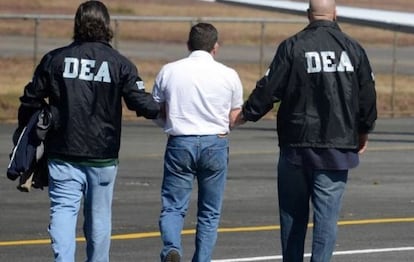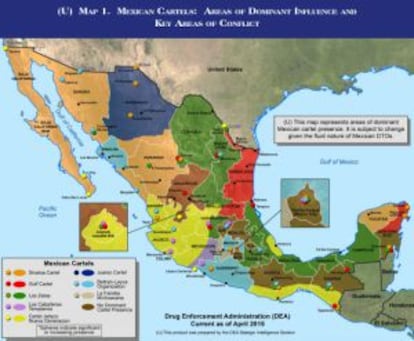FARC guerrillas working with Mexican cartels to ship cocaine into US
DEA report analyzes the influence of Mexico’s criminal gangs on American narcotics market


Revolutionary Armed Forces of Colombia (FARC) guerrillas have been working alongside Mexican drug cartels to transport high quantities of cocaine into the United States, according to a US Drug Enforcement Administration (DEA) report.
Mexico’s powerful narcotics-smuggling organizations have taken advantage of their proximity to the United States to do business with the FARC, which supply them with cocaine processed in the jungles of Colombia.
Mexico’s cartels have taken advantage of their proximity to the US to do business with the FARC
“While [Colombian criminal gangs] are involved in the production and transportation of cocaine to Central America and the Caribbean, the FARC are increasingly working with Mexican [cartels] to smuggle ton quantities of cocaine into the United States,” reads the 148-page report on drug trafficking in the United States.
“Investigative reporting indicates a working relationship between multiple FARC fronts and Mexican [cartels], including Beltrán Leyva, Jalisco Nueva Generación and the Sinaloa cartel to transport cocaine into the United States.”

While the DEA report states that Colombian authorities have dealt severe blows to the country’s criminal gangs, one powerful group of traffickers that has emerged are Los Urabeños. The DEA believes it “to be one of the major Colombian organizations supplying large quantities of illicit drugs to the United States.”
Mexican cartels have established drug distribution points in cities such as Boston, Chicago, Los Angeles and Philadelphia.
Sinaloa cartel leader Joaquín El Chapo Guzmán, who is the subject of an international manhunt following his escape from a high-security prison in Mexico in July, is alleged to control the markets in many major US cities, authorities have said.
The Sinaloa cartel is without doubt one of the biggest exporters of illegal narcotics to the United States. The DEA has called it “an active supplier” to US markets.
It has an extensive network of smuggling operations along the Mexican-US border, and has used secret tunnels running from one side of the frontier to the other for shipping drugs.
But the DEA believes that the Jalisco Nueva Generación cartel is gaining ground as it receives support from other groups.
“The Jalisco Nueva Generación is quickly becoming one of the most powerful transnational criminal groups in Mexico and in some cases rivals Sinaloa Cartel trafficking operations in Asia, Europe, and Oceania,” the report states.
The 2015 National Drug Assessment Summary also provides a detailed map of where the major cartels are located in Mexico.
“Mexican transnational criminal organizations pose the greatest criminal drug threat to the United States; no other group is currently positioned to challenge them,” the report said.
Besides tunnels, the cartels also rely on small fast boats, trains and ultralight aircraft to get their shipments across the border. Once in the US, the narcotics are shipped by land by hired people.
The Jalisco Nueva Generación rivals Sinaloa Cartel trafficking operations in Asia, Europe, and Oceania” DEA report
The Sinaloa cartel, for example, hires long-haul truck drivers so as not to attract the attention of authorities. Many of these drivers are unaware where the drug shipments will eventually end up, so they cannot give many details if they are caught.
The cartels’ US operations tend to be more low profile than those in Mexico, where shootouts between rival gang members and authorities frequently occur.
English version by Martin Delfín.
Tu suscripción se está usando en otro dispositivo
¿Quieres añadir otro usuario a tu suscripción?
Si continúas leyendo en este dispositivo, no se podrá leer en el otro.
FlechaTu suscripción se está usando en otro dispositivo y solo puedes acceder a EL PAÍS desde un dispositivo a la vez.
Si quieres compartir tu cuenta, cambia tu suscripción a la modalidad Premium, así podrás añadir otro usuario. Cada uno accederá con su propia cuenta de email, lo que os permitirá personalizar vuestra experiencia en EL PAÍS.
¿Tienes una suscripción de empresa? Accede aquí para contratar más cuentas.
En el caso de no saber quién está usando tu cuenta, te recomendamos cambiar tu contraseña aquí.
Si decides continuar compartiendo tu cuenta, este mensaje se mostrará en tu dispositivo y en el de la otra persona que está usando tu cuenta de forma indefinida, afectando a tu experiencia de lectura. Puedes consultar aquí los términos y condiciones de la suscripción digital.
Últimas noticias
Most viewed
- Reinhard Genzel, Nobel laureate in physics: ‘One-minute videos will never give you the truth’
- Oona Chaplin: ‘I told James Cameron that I was living in a treehouse and starting a permaculture project with a friend’
- Pablo Escobar’s hippos: A serious environmental problem, 40 years on
- Why we lost the habit of sleeping in two segments and how that changed our sense of time
- Charles Dubouloz, mountaineering star, retires at 36 with a farewell tour inspired by Walter Bonatti








































